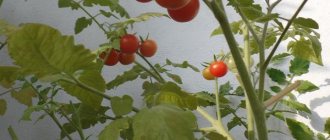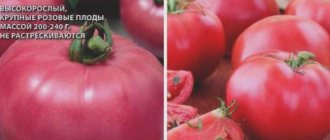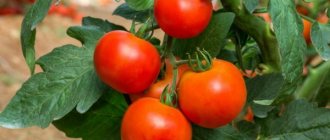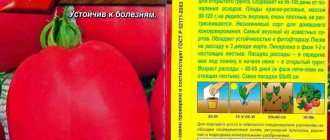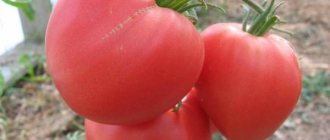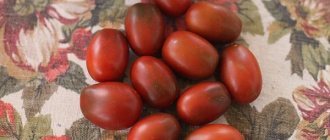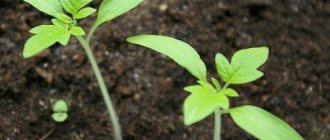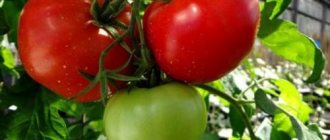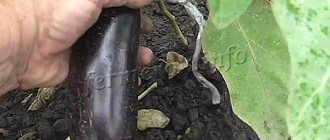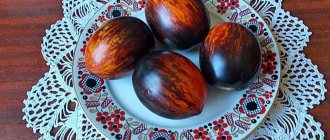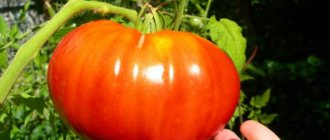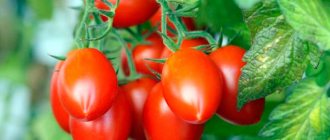Bright red, presentable and tasty tomatoes are in fashion. They are loved by farmers and adored by buyers at markets. Strawberry Cherry tomato F1 is just such a hybrid, producing wonderful small fruits with excellent taste and marketability. Stands out from all the others with its interesting shape, reminiscent of a strawberry, and a high level of endurance
| Height | Landing location | Ripening time | Fruit color | Fruit size | Origin | Fruit shape |
| Medium height | Greenhouse, Open ground | Early ripening | Reds | Small | Hybrid | Heart-shaped |
Tomato Kangaroo Heart description and characteristics of the variety, its yield with photos
Just think, but 20 years ago gardeners were not tormented by the question of what variety of tomatoes to plant - they simply did not exist.
Now the seed market is flooded with various varieties for certain climatic conditions, including for greenhouses. How not to drown in the stream of names and make the right choice? All experts agree that it is indeterminate or tall varieties of tomatoes that are ideal for greenhouses. They form into one stem and its growth is not limited as long as there is space and favorable temperature conditions. Of course, they need more careful care, but at the same time the yield increases significantly.
In particular, with proper care and watering, you can harvest up to 50 kg of tomatoes from a bush.
The main advantages of indeterminate varieties:
- The bush gives more harvest due to more color brushes
- They are less susceptible to fungal infections due to greater air intake
- Long fruiting phase, which allows you to enjoy tomatoes for a long time
- Bushes are much easier to form, since you only need to leave the stem without stepsons
The disadvantages include:
- Tomatoes are very picky about heat and care, so they may not grow in all areas.
- Unlimited growth, not only in height, but also in width, not suitable for small greenhouses and areas
- Due to precocity, a disadvantage may arise such as different sizes of fruits on one bush
In contrast to tall varieties, determinate varieties perform very well in different climatic conditions and require less care. But at the same time, they have limited growth and, therefore, limited yield. This species is also suitable for growing in greenhouses, especially if there is not much space.
The main advantages of determinate tomatoes include:
- Early fruits. They ripen earlier than identerminate ones, since the flower clusters are formed through fewer leaves.
- High level of early harvests in various climatic zones.
- More uniform harvest yield - several tassels are tied at once and almost at the same time.
Cons of determinate tomatoes:
- The overall yield is lower than that of tall ones, again due to the small growth of the bush.
- Diseases. These varieties are more prone to diseases. Loaded brushes reduce their resistance to viruses. That is why these varieties need to be treated more with chemicals.
- Increased fertilizer and mineral nutrition, again, due to the load on the brushes.
De Barao
One of the most famous varieties of indeterminate tomatoes. Its bushes reach up to 3 meters. At the same time, it can be cultivated both in a greenhouse and in open ground. From each square meter you can harvest a high yield - up to 10 kg per bush.
Like all tall trees, it has increased resistance to diseases. De Barao is divided into several subspecies (pink, royal, gold, black, red, yellow) depending on the color of the fruit, but with the same characteristics - large yield and high stature.
Also one of the leaders in tall tomatoes. It is ideal for growing in greenhouse conditions, and it looks quite interesting. A 3-meter tree with vines on which the treasured tomatoes grow. From such a tree you can get 1-1.5 tons of harvest. At the same time, the fruits have an excellent taste and can be stored for several weeks and even months if properly maintained.
Semko-Sinbad F1
Classic to represent an early, fruiting variety. A very early variety, the first fruits can be harvested after 90 days. On its branch, 8 fruits are formed, weighing 100 g. The variety can be grown not only by seedlings, but also by planting seeds directly into the ground, while it has high resistance to infections.
Bourgeois
This is a mid-season variety, the fruits of which can be removed from the branches on the 100-110th day after planting. The average weight of such a fruit is 200 g. Due to its resistance to temperature changes, it grows well both in the southern regions and in the regions of the middle zone. With quality care, gardeners harvest up to 3 kg of fruit from one bush.
Hybrid Ivanhoe F1
Originally from Holland, tomatoes are loved by Russian amateur gardeners. Like all determinate varieties, Ivanhoe is unpretentious to the weather and easy to grow. The taste is much brighter than other greenhouse varieties of tomatoes, and early fruits can be obtained already at the beginning of summer.
The nuances of breeding in greenhouse conditions and in open ground
Long daylight is a necessary condition for the full growth and development of the hybrid.
To prevent the bushes from stretching out, select beds in a sunny, draft-free place. To protect the plants from wind and precipitation, install an additional support next to the bush, to which it is fixed immediately upon replanting. To limit the growth point, pinch the tops of plants.
This procedure is especially important in greenhouse conditions, since the growth of greenhouse bushes is usually higher than outside. All lower leaves must be removed. With constant contact with wet beds, they can rot and cause the development of fungal diseases.
Since the crop needs fertile soil, it is necessary to remember the rules of crop rotation, which recommend planting tomatoes on the land where legumes, cabbage, carrots or winter crops were previously grown. After peppers, potatoes and eggplants, the tomato will lack nutrients, since previous crops greatly deplete the soil.
When planting in a greenhouse, the top layer of soil must be changed, and the new soil must be disinfected with a weak solution of potassium permanganate to destroy pathogenic flora. You can also treat with copper sulfate, which serves as a preventative against late blight.
Tomato "Orange Strawberry": delicious orange giant
One of the reviews about this tomato said one word: “Bomb!” The author was speechless with emotion and delight at how pleased he was with the harvest and the taste of large fruits of bright orange color, similar to a heart, only rounded.
general information
The variety was given a second life by now popular online stores and private farms selling “their own” seeds. Some of them got confused themselves and confused buyers. Now lovers and even sellers confuse the two varieties of “orange strawberry” and the “German orange strawberry” tomato.
No one can say where the name “Orange Strawberry” came from; 30 years ago there was no such variety, but there were other names for a similar species. Gardeners themselves became breeders: by keeping the best specimens for seeds, they achieved the best qualities of this species, and those who sell seeds developed an improved variety and gave it a new name.
Resistance to diseases and pests
Judging by the reviews and photos of the yield in September and October, the “Orange Strawberry” tomato is practically not susceptible to disease if you follow simple rules and prevention.
Advantages and disadvantages
Having familiarized yourself with the “Orange Strawberry” tomato, the variety description of which is presented above, you can highlight its pros and cons.
Even with a stretch, no one could provide any downsides.
Therefore, the variety is worthy of being grown.
Features of cultivation
Orange Strawberry tomatoes do not require special growing conditions.
The variety belongs to the mid-season type, so it should be sown no earlier than March, calculating the dates for your region.
After sowing the seeds, remove the container to a warm place, not lower than 25 °C, and as soon as the seeds hatch, move them to the light and maintain the temperature at 15–16 °C for 7 days, then increase the temperature to 20–22 °C.
When the first two leaves appear, transplant the seedlings into larger boxes or separate containers, not forgetting to feed them with superphosphate and potash fertilizers.
In indeterminate varieties, the first flower cluster appears no earlier than the eighth leaf, so the main task is to prevent the seedlings from stretching.
To enhance root growth, plant in high pots, and as the bush grows, add soil. The land is also important: it must be fertile and neutralized.
Plant in pre-prepared holes: 1 liter of sifted ash, 1 liter of humus, two spoons of superphosphate. Water the hole well and sprinkle mulch on top.
Do not fertilize or treat plants for two weeks.
- increasing productivity;
- stimulation of growth points;
- increasing the sugar content of fruits;
- increase in yield by 15–20%.
Water deeply, but infrequently, and the mulch will retain moisture longer, preventing it from evaporating.
Feeding for large-fruited varieties is very important, but is not done during fruiting.
Tomatoes will respond well to root feeding:
- manure infusion: take 1 liter per 10 liters of water, add 1 liter of ash and a tablespoon of superphosphate and pour 0.5 liters under each root, do this when increasing the mass;
- During fruiting, you can feed the plants for the smooth ripening of fruits with the following solution: 1 tablespoon of nitrophoska and 1 teaspoon of sodium humate per 10 liters of water, add 0.5 liters under the root.
There is nothing complicated to get a “bomb” tomato! The variety is good in all respects and will return your love in the form of “orange strawberries”, so similar to a big sunny heart.
What is “black strawberry”
It has a classic spherical shape, but depending on growing conditions it can also take on an elongated shape. The average size of the fruit is 10 cm in diameter and weighs 70 – 100 grams. At the flowering stage, the fruit can be confused with a plum due to the same shade, but it differs in size and shape.
Many gardeners recommend tying up this tomato bush. The height of the bush, judging by the reviews of many of our customers, reaches up to 2 meters, and the weight of the tomato itself reaches 150 - 170 grams. The inside has a pink or red tint, as well as an elastic outer shell, but the inner “component” is juicy and soft. They are not afraid of overheating in the sun. Therefore, they can easily be planted both in the country and in the greenhouse.
Description of the Strawberry tomato, cultivation and further care
Among gardeners who strive to harvest an early harvest, the Strawberry tomato is very popular. The tomato has excellent taste, is unpretentious in cultivation and care, and also has high yield. Before you start growing it, you should familiarize yourself with the variety and the features of caring for it.
The Strawberry variety is divided into two types - orange and red tomatoes. The yellow-orange fruits are believed to have a richer sweet taste and are most often used in salads and sauces. The red variety is used more universally. Its taste combines spice, sugar, acid and light fruity notes. This is what experienced gardeners most often grow.
Characteristics of the variety
Tomato Strawberry F1 is an indeterminate species. An adult plant can reach a height of one and a half meters. The trunk of the bush needs additional support and support, so strong supports should be installed in advance so that branches can be tied up in the future. The variety is suitable for growing both in greenhouse conditions and in open ground. Tolerates minor temperature changes and drought well.
The early-ripening variety allows you to get the first harvest within 85-90 days after sowing the seeds.
- Ripe fruits have an unusual shape that looks like a strawberry.
- Tomatoes are small in size; on average, each fruit weighs from 20 to 50 g.
- Some specimens can reach even more impressive sizes.
- The color of tomatoes depends on the variety chosen; they can be orange or red.
- Tomato productivity is high; 5-7 kg can be harvested from one bush per season.
The taste and aroma of this variety will not leave anyone indifferent. The pulp of the fruit is dense and sugary, there are few seeds, the peel is thin and easily removed. The tomato is dense and perfect for canning whole. These fruits are not entirely suitable for making paste or juice, since they contain a lot of dry matter.
Growing and care
When purchasing strawberry cherry tomato seeds, you should carefully study the description and recommendations regarding sowing and further care of the plant.
Plant the seeds in a container with previously prepared soil. You can prepare a special soil yourself; to do this, you need to mix some soil, peat and river sand. After planting, the container is stored in a warm room with good lighting. Watering seedlings must be done carefully so as not to wash the seeds from the soil. For this it is best to use a spray bottle.
As soon as a couple of green leaves appear on the young Strawberry sprout, you can start picking. You can plant the planting material directly in peat pots. This will simplify and speed up the process of planting in open ground in the spring.
Seeds are sown at the end of March or beginning of April, and seedlings are planted in open ground or in a greenhouse in the first half of June.
Like all varieties of tomatoes, the Strawberry tomato loves fertile soil, so before planting seedlings, the soil should be properly prepared. To do this, humus, wood ash and complex fertilizers are added to the soil. Gardeners know that the soil should be fertilized in the fall before digging.
Planting material is planted sparsely, leaving 40 cm between bushes, and about 60 cm between rows. Immediately after planting, Strawberry bushes are watered with settled water. The holes are mulched; for this it is best to use ordinary sawdust. Vegetable growers prefer to immediately install a support for further garter.
Caring for a tomato does not require much effort, since the plant is unpretentious and has good immunity to many diseases.
But there are still certain requirements for caring for the Strawberry variety:
- Watering is carried out regularly, but dampness and excess moisture are avoided.
- Loosening the soil is a necessary procedure. You need to fluff up the soil 2-3 times a week.
- It is periodically necessary to apply complex fertilizers to the soil.
- Gardeners recommend pinching and forming the bush into one stem.
Description of the variety
The f1 hybrid was bred by Russian breeders and included in the State Register of Breeding Achievements. Recommended for cultivation in open ground and in greenhouse conditions. Adapts well to temperature changes and drought.
Distinctive features
Indeterminate type, height up to 1.5 m, dense foliage, large, bright green leaves.
Reference ! The indeterminate type has no restriction on the growth of the main stem.
An early-ripening hybrid, 90-95 days pass from the moment of sowing the seeds to full ripening.
The productivity is high, up to 5 kg of fruits are harvested from 1 bush, provided that 2-3 seedlings are planted per 1 sq. m. m.
The hybrid genes contain high resistance to many dangerous diseases of the nightshade family.
The culture requires mandatory gartering and pinching. To improve the fruiting rate, plants are formed into 1 trunk.
Fruit characteristics
Average weight is 20-50 g, the shape is not typical for a tomato: ripe vegetables resemble strawberries. The color is bright red. The taste combines spice, sugar, acid and light fruity notes. The pulp is dense, there are few seeds. The peel is thin, but the fruits do not crack during heat treatment.
Reference ! Hybrid Strawberry is divided into two subspecies: orange and red tomatoes. The yellow-orange fruits have a richer sweet taste and are great for making salads and sauces.
Ripe vegetables are consumed fresh: for preparing salads, various snacks, canapés; due to their small size, they are used for whole-fruit canning.
They are not suitable for processing into tomato products due to their dense pulp. Tomatoes are subject to long-term storage and can withstand long-term transportation, which makes it possible to breed the crop for sale.
The photo shows Strawberry tomatoes.
Area of application of fruits
The fruits of the “Anyuta” f1 tomato are stored for a long time without losing their gastronomic qualities. They are well transported to the place of sale. They supply tomatoes to retail outlets, restaurants and catering facilities. Eat fresh and make salads. In homemade preparations they are used for making juice, pickling, and canning.
Resistance to diseases and pests
Hybrid tomato "Anyuta f1" has good immunity against common nightshade infections. The variety is not affected by: macrosporiosis, a type of fruit and root rot, mosaic, fruit cracking. Possible late blight. Among the insects that parasitize the crop are nematodes, larvae of the Colorado potato beetle and whitefly moth, and less commonly, spider mites.
Advantages and disadvantages of the variety
Hybrid tomato species rarely have serious deficiencies. During experimental cultivation, breeders eliminate the shortcomings of the variety. The conditional disadvantages of the “Anyuta” f1 tomato include average resistance to pests and the need for sufficient lighting. Excess or deficiency of moisture is not relevant for tomatoes.
According to vegetable growers, Anyuta f1 tomatoes (pictured) are characterized by a number of advantages:
- grown in open ground and protected structures;
- good taste and aesthetic presentation;
- the variety reaches biological ripeness at the beginning of summer;
- Two crops are harvested per season;
- tomato is undemanding to watering;
- resists diseases well;
- The fruits are of a convenient size, suitable for preservation.
A universal tomato.
Mistakes of summer residents
Growing this crop requires some knowledge and skills, so beginners are not always able to get a tasty and abundant harvest in the first year of planting. This happens for several reasons:
- using expired or infected seed that does not germinate well and produces diseased seedlings;
- sowing in too small a container, as a result, the seedlings suffer from a lack of nutritional components and space for root development - they turn yellow and wither;
- lack (or excess) of light or moisture, which also negatively affects the development of young shoots;
- transplantation without accustoming to sunlight and fresh air - such sprouts usually quickly wither from freezing or turn yellow from overheating in the sun;
- lack of basic care - watering, fertilizing, preventive treatments, loosening and weeding;
- tomatoes growing in weed thickets will produce a meager harvest and begin to get sick.
Agrotechnics of cultivation
All varieties of tomatoes with unlimited growth in central Russia are traditionally grown in spring-type greenhouses using natural solar heating using seedlings.
- Seeds are sown to obtain seedlings 60-65 days before transplanting to a permanent location. The dates are variable and depend on local climatic conditions and the quality of the greenhouse. Approximately the last ten days of March.
- To grow strong, healthy seedlings, it is necessary to monitor the temperature and light conditions, preventing the seedlings from stretching. Seedlings are planted at the stage of 1-2 permanent leaves in separate containers or boxes.
- Transplant seedlings into a greenhouse at the rate of 3-4 plants per square meter. m. Planting density depends on how the plant will be formed.
- It is recommended to leave only one main stem. This will allow the plant to grow quickly, form fruits and allow large fruits to ripen within the stated time frame.
- But many vegetable growers cope with a more difficult task by growing tomatoes in several stems. At the same time, the timing of harvest ripening is delayed. The plant itself requires timely pinching of growth points, removal of stepsons and dying foliage.
- Like all tall tomatoes, the variety is responsive to timely watering and proper feeding. After watering, be sure to loosen the soil and hill up the lower part of the stem, covering the adventitious roots in the top layer of soil with a layer of earth.
- Too nutritious soil is not suitable for indeterminate varieties; they begin to grow green mass too quickly to the detriment of the size of the fruit. This also applies to watering, which should be moderate at the initial stage of the growing season. After the appearance of the first fruits with a diameter of 4-5 cm, watering is increased to 2-3 liters per 1 bush.
Otherwise, caring for a tall variety is not much different from caring for other tomatoes.
The variety is quite young. But reviews of the Strawberry Tree tomato indicate that its characteristics are very impressive not only to gardeners in the Siberian and Far Eastern regions. The high-yielding variety is suitable for gardeners in the western and southern zones. Such an interesting tree with tomatoes can be easily grown outdoors and in warm climates. With the recommended planting scheme and a longer growth period, you can get up to 20-25 kg of tomatoes per square meter. m. area.
The future harvest also depends on the preparation of seedlings. To get good planting material, you need to sow the seeds 60-70 days before transplanting the seedlings to a permanent place. To grow seedlings, prepare a substrate from a mixture of equal parts of sand, fertile soil and humus. To deoxidize the mixture, add 2 tbsp. l. chalk or ground eggshells for every 10 kg of soil.
Steam the substrate in the oven or soak it in a hot solution of potassium permanganate. After cooling, place the seeds on moist soil and cover with 0.5 cm of dry sand or soil. Cover the box with glass. Germinate seeds at 25°C.
We invite you to familiarize yourself with: Technology of growing cabbage in a greenhouse
After blooming, 1 flower cluster is fed with phosphorus-potassium mixtures (3 tablespoons of superphosphate and 10-20 g of potassium monophosphate per 10 liters of water) or wood ash (300-500 g per 10 liters). Repeat the same feeding after 2 weeks. Do not apply nitrogen mixtures during fruit growth.
Form a Strawberry tree by removing all the stepsons down to 1 flower cluster. You can leave 1 side shoot above it, if you need 2 stems. For the third stem, leave 1 stepson above the 2nd fruit cluster. The remaining shoots must be removed as they grow.
Features of cultivation and storage
The hybrid is replanted stably when the seedlings reach the age of 55-60 days.
Holes 30 cm deep are dug in the beds. The following is added to each:
- a handful of compost;
- 10 g of phosphorus-potassium mixture;
- a handful of wood ash.
Formation is carried out in 2-3 trunks.
What are the secrets of good harvests:
- Regular feeding with nutrient mixtures and bioinfusions, preference is given to such compositions as “Agricola” and “Agrofit”.
- Moderate watering, water norm is 6-7 liters per bush.
- Mulching beds with straw and sawdust.
Ripe tomatoes keep well for up to 1 month. Set up dark, cool spaces for storage.
Agricultural technology varieties
It is worth planting tomatoes in open ground after the threat of repeated frosts has passed. Choose a sunny place for planting, without drafts. The soil is prepared in advance. They apply fertilizers, remove weeds and dig up.
Leave the soil for several days to settle. Then holes are made into which a stake is immediately placed for further attachment of the plant to it. Place 1 large spoon of wood or grass ash at the bottom of the hole. Seedlings are placed on it and buried in soil. Water well.
The plants are watered regularly at first, as the top layer of soil is ventilated. As soon as the seedlings have taken root, watering is reduced to 3 times a week. If the weather is humid, then watering is not carried out in open ground, but in a greenhouse it is watered once a week. During active flowering and fruit formation, watering is resumed. Water for watering plants is used that is heated and well settled. Cold water from a hose can slow down the plant's growing season. The fruits will take a long time to ripen.
Fertilizing Purple strawberry tomatoes should be done 3-4 times per season. The first feeding is carried out a week after planting the seedlings in a permanent place. The second - after 10 days with phosphorus-containing and potassium fertilizers. The third - during the period of flowering and fruit set with a complete mineral complex. The fourth - during the period of fruit ripening with phosphorus-containing and potassium fertilizers.
You need to form a bush into 2 trunks. This will distribute the fruit load throughout the plant. The remaining stepsons must be removed regularly, otherwise the yield will fall.
How to grow tomatoes
After 2 months, the seedlings are ready for transplanting. If the soil temperature is less than +15, then planting in the ground should be delayed, otherwise the seedlings will not begin to grow for a long time, which will delay fruiting.
Landing
The Strawberry tomato loves fertile soil, so humus, wood ash and complex fertilizers are added to the soil.
Planting pattern: 40 cm – distance between seedlings, 60 cm – row spacing. For 1 sq. m place no more than 2-3 plants.
After transplanting, the holes are watered with warm, settled water and mulched with sawdust. Mulching helps retain moisture in the beds longer and prevents the penetration of many pests.
Further care for tomato Strawberry F1
Regular watering is established as young plants adapt to new conditions. Water infrequently, 1-2 times a week, increasing the number of waterings on dry days. It is important to avoid dampness in the beds. Tomatoes do not like excess moisture, and high humidity has a negative effect on developing fruits, giving them a watery taste.
After each watering, the beds are loosened, removing weeds with roots.
Reference ! Weeds can be used as mulch. When rotting, it will feed the root system with additional beneficial substances.
Plants need feeding regularly. The fertilizer is a full complex of minerals, which is added to irrigation every 2 weeks. During the budding period, phosphorus and magnesium are added to the main fertilizing for healthy growth and development of plants, and during fruiting, potassium fertilizers are used for faster fruiting.
Features of cultivation and possible difficulties
When transplanting, vertical wooden or metal supports are installed next to each bush. Despite the powerful bush, the plant requires obligatory staking not only of the stem, but also of the fruit-bearing branches, since they cannot withstand the weight of ripe vegetables.
The ideal fixation option is a garter on a trellis. To do this, install supports at different ends of the bed and stretch wire between them.
Tall bushes require regular pinching, otherwise a lot of nutrients will be spent on the growth of unnecessary shoots. In addition, if the plants are not planted, there is a possibility that the plantings will become dense, which will lead to the development of fungal spores and the spread of insect pests.
For the greatest return, the crop is formed into 1 stem. This is a necessary condition for those who want to get maximum yield.
Diseases and pests
The hybrid is immune to diseases of the nightshade family. But for the purpose of prevention, it is recommended to regularly loosen and mulch the beds, control the level of humidity and systematically ventilate closed structures.
The influx of fresh air destroys not only the pathogenic environment, but also the habitual living conditions of many parasites, in particular the greenhouse spider mite.
Young bushes are susceptible to attacks by the Colorado potato beetle, which is why regular and thorough inspection of plants is so important. The beetle is collected by hand and burned in glass jars. If there is a lot of it, use the drug “Prestige”. But remember that the use of insecticides is possible only before the ovaries appear.
Advice . Planting sharp-smelling plants next to tomatoes will protect them from many ground and flying pests. Pheromone traps will protect against whitefly butterflies, and treating the stems with a soap solution will protect the bushes from slugs and aphids.
Characteristics and description of the tomato variety Strawberry dessert
Those who have grown the Strawberry Dessert tomato note the undoubted advantages of the new variety. Low maintenance and early fruit ripening make these tomatoes popular among gardeners.
External characteristics of the variety
The characteristics and description of the variety define the plant type as indeterminate (without limiting the growth of the main stem). These are tall tomatoes that can reach a height of 1.7 m during the growing season. The plant requires a garter. It is convenient to grow tall tomatoes on a trellis, tying the bushes to a vertically stretched wire as they grow.
It takes 120 days from sowing the seeds to harvesting the harvest. The beginning of fruiting of strawberry dessert tomatoes occurs in the 1st-2nd decade of July. The growing season of the plant continues until the first frost when grown in open ground.
The fruits are fleshy and large, with an average weight of about 300 g, red with a ruby tint. The shape of the fruit is rounded and flattened, with slight ribbing. The skin is thin, the flesh is juicy. The average yield is 10-12 kg of ripe fruits from 1 bush.
Taste benefits of fruits
Reviews from gardeners who have already planted Strawberry dessert tomatoes note the excellent taste of the fruits of this variety. Tomatoes have a high content of sugars and dry matter. This combination creates a richly sweet taste of the fruit (like strawberries), with a pronounced aroma characteristic of tomatoes.
The thin skin allows Strawberry Dessert tomatoes to be used for making salads from fresh vegetables. Thanks to its juicy pulp, the fruits are suitable for processing into purees (for adjika, lecho) or for making tomato juice. The large size and fragile skin do not allow salting and pickling tomatoes as a whole.
Agricultural technology varieties
In Russian conditions, tomatoes are grown only by seedlings. Seeds are sown in mid-March. Up to 80% of the seed germinates, seedlings appear within 5-7 days. Seedlings need to be picked in the phase of 2 true leaves, planting them in separate pots with a diameter of 7 cm or at the same distance in a common box.
The timing of planting strawberry dessert tomatoes in open ground depends on the cessation of return frosts. The average time when seedlings can be planted in the ground is late May-early June. 7-10 days after planting, the seedlings need to be tied to a support.
For normal growth and rapid fruit set, the bushes must be fed with complex fertilizers containing nitrogen, phosphorus and potassium. Do not water tomatoes with a solution of fresh mullein or bird droppings. It is recommended to add organic matter to the site in the fall, in a rotted form.
The main difficulty of care is the formation of a bush into 1 stem. To do this, you need to monitor the growth of tomatoes and shoot the bushes as the side shoots grow in the leaf axils. It is better not to break out overgrown stepsons, but to pinch them over 1 flower brush.
Some tomatoes from the bushes will have to be picked green. Strawberry dessert tomatoes ripen well in a warm room.
Advantages and disadvantages of the variety
Among the advantages of the variety are the excellent taste of the fruits and the high shelf life of the harvested products. Other advantages of Strawberry dessert can be noted:
- the plant is resistant to root rot and blackleg, which allows you to save a large number of seedlings;
- fruits are practically not susceptible to late blight and blossom end rot, even in cool and humid summers;
- fruiting is extended, which allows you to collect ripe tomatoes for fresh consumption throughout the season;
- high yields provide all the needs of the gardener.
Other "strawberry" varieties
The Strawberry hybrid is not the only one of its kind, reminiscent of everyone’s favorite garden berry. There are other varieties with similar names.
Tomato Strawberry Dessert
Indeterminate type, requiring obligatory gartering and pinching. The ripening period is average, it begins to bear fruit 120 days after sowing the seeds. Fruiting is extended, lasting until the first frost. Designed for breeding in greenhouse conditions.
The fruits are large, up to 300 g, red with a ruby tint. The taste of vegetables is excellent, richly sweet with a high content of sugars. The variety is high-yielding, at least 10 kg are harvested from 1 bush. There is increased resistance to diseases.
Tomato Strawberry Tree
Indeterminate mid-early variety, begins to bear fruit in 100-110 days.
It takes root equally well both in open ground and in greenhouses. Productivity is high, from 1 sq. m harvest up to 12 kg of fruit. It is highly resistant to diseases such as tobacco mosaic virus, verticellosis, brown spot and cladosporiosis.
The culture requires mandatory gartering and pinching. Ripe vegetables of excellent taste, sweet with barely noticeable sourness, weighing up to 200 g.
Shrubs are often planted in front gardens; their form as a small ornamental tree can decorate any area.
Tomato German red strawberry
Semi-determinate, early ripening species, 100-115 days pass before fruit ripening. Recommended for open ground and greenhouse conditions. The variety is high-yielding, up to 7 kg of fruits are harvested from 1 seedling. Immune to most diseases.
Gartering and pinching plants is a mandatory procedure in tomato care. Unlike other varieties, the origin of tomato is Germany. Ripe fruits are large, 250-500 g, the taste is excellent, sweet, the color is deep red or orange. The culture can be propagated using both seedless and seedling methods.
Hybrid Cherry strawberry
An early-ripening, medium-sized hybrid, recommended for open and protected ground. Fruits in 90 – 100 days.
Immune to typical diseases of the nightshade family. Productivity is high, from 1 sq. m harvest up to 9 kg. It is distinguished by the excellent taste of vegetables and their appearance: it is a copy of a strawberry.
The taste is sweet due to the high sugar content, the color is bright red. Tomato bushes, strewn with fruits, look like decorative decorations for garden plots.
Ripe vegetables are immediately processed, as they cannot be stored for a long time.
Description of the tomato variety Orange Strawberry and its yield
Orange strawberry is a tomato brought to us from Europe. It is one of the non-hybrid plants that Germany is proud of. Bred by German breeders 50 years ago. The bushes do not cause trouble when growing, have an original taste and have decent yield.
The seeds of the Orange Strawberry tomato variety are passed from one gardener to another, so it is resistant to most nightshade diseases. The vegetable also tolerates the effects of chemicals well. Over the years of cultivation, the tomato has acquired a reputation as an unpretentious fruit that you will want to plant on your plot next year, since the reviews about it are only positive.
What is Orange Strawberry?
The description of the variety is as follows. Tomatoes of the German strawberry variety are tall plants and sometimes reach 2-3 m. The bushes have expressive bright orange fruits that resemble a heart, around which narrow green leaves grow. Depending on the seeds purchased, the German orange strawberry tomato can be not only heart-shaped, but also cone-shaped.
It attracts with its unusual appearance and taste, the characteristics of which delight most lovers of these fruits. German strawberries are juicy, fleshy tomatoes with a sweet and sour flavor.
When compared with other varieties, the fruits are large (400-600 g), and there are almost no seeds inside. German orange strawberries bear 6-10 fruits. Up to 8 kg is harvested from 1 bush, so the yield is considered average. The plant is unpretentious and grows well in open ground and in greenhouse conditions. Fruiting is long: from July to the end of October.
Positive and negative aspects of the variety
The Orange Strawberry tomato has earned a positive reputation among most gardeners, since it has certain advantages over other varieties.
unpretentiousness;
early ripening;
disease resistance;
mass ripening of fruits;
a shape and original taste that is unusual for many regions.
There are also small disadvantages to the variety: the German orange strawberry tomato is a voluminous and tall plant. If you plant tomatoes in open soil, you can do without pinching. But this variety of tomatoes is very dependent on feeding. To avoid a decrease in yield when growing on poor soils, it is advisable to apply fertilizers.
Preparing the soil for planting
To grow tomatoes from seeds and reap a good harvest, you need to properly prepare the soil. Experienced gardeners recommend planting seeds in self-prepared soil, consisting of loamy soil with the addition of compost or humus.
To make the soil more loose, sawdust should be added to it. The simplest option for growing seedlings of the German orange strawberry variety is peat tablets, which can contain 3-5 seeds. The convenience of such tablets is that there is no need to pick seedlings.
Also known as Orange Strawberry, this variety is almost immune to the diseases that nightshade plants are prone to. But this does not mean that it does not need to be looked after.
The most common pests that threaten the fruits and green leaves of the plant are whiteflies, spider mites and thrips. You can destroy them by sprinkling the bushes with a decoction of celandine or with chemicals intended for processing tomatoes.
Growing seedlings
Tomatoes need to be planted in open soil.
But before that, seedlings need to be grown from seeds. Preparation of planting material
For better bush growth, you need to prepare the seeds in advance. To do this, you need to prepare a solution using substances such as copper sulfate, boric acid or aloe juice and soak the seed in it for several hours. It is worth noting that there are other ways to treat seeds. For example, soaking in water. To do this, you need to pour water into a small bowl after placing a cloth in it. Then you need to lay the seeds on its surface.
After 2-3 hours of soaking, you need to drain the water, and place the seeds in a plastic bag and store them there for about three days. Soaking can also be carried out using a manganese solution. It needs to be poured into a plate with the planting material. You need to soak for no more than 30 minutes, after which the seeds need to be washed with water and dried.
Landing
- The best conditions for planting tomatoes will be light and loose soil. Therefore, before you start planting seeds, you need to add a small amount of peat with sawdust to the soil.
- In order to avoid having to resort to transplanting seedlings, seedlings should be grown in peat tablets. You need to start planting tomato seeds at the beginning of March. It is worth noting that some gardeners do this at the end of the month. The maximum depth of the holes in which the seeds will be planted should not be more than one centimeter. The distances between the holes should be from 5 to 7 cm, if the planting material will be planted in boxes. If the growing conditions are correctly met, then after 5-10 days the first shoots can be observed.
- To avoid stretching of young shoots, you need to make sure that there is good lighting in the garden bed. The duration of daylight hours should be at least 15 hours a day. According to the recommendations of some gardeners, in the first few days after the first shoots appear, lighting should be provided around the clock.
tomato Cypress - description and characteristics of the variety
Planting seedlings
Planting should be done in open ground and only after the period of night frosts has ended. Seedlings should begin to be planted from April 15-20 or from the beginning of June. By this time, the root system of the bushes will already have time to strengthen, and the first sprouted tassels will appear.
Site selection
The choice of planting site is also a very important factor. You need to choose a place that will have good lighting. If the site is located on a hill or in a place where strong gusts of wind are constantly observed, then such an area is not recommended for planting. It would also be a good idea to ask what grew on the site before. It is necessary to consider whether related crops were grown in a given location. The tomato grows well after eggplant, pepper or potato.
Kiwi tomato - description and characteristics of the variety
Soil preparation
Strawberries, like many other tomato varieties, are not very picky about soil. But still, soil that contains more nutrients will better stimulate the bushes to grow. Therefore, before planting on the site, you need to fertilize the soil. Usually compost and humus are added to the soil. 5 kg of fertilizers need to be placed per square meter.
Planting
Before planting, you need to create the appropriate number of holes on the site. They shouldn't be very deep. The ideal option is when the hole completely covers the root of the seedling. Each hole should be at least 40-50 cm from its neighbor, the rows should be located at a distance of at least 60 cm. Those seedlings that are more than 35 cm in height are planted in the ground at a right angle and you need to dig in not only the root of the bush, but and a third of the stem. After placing the seedling in the hole, it must be covered with earth and compacted. After this, it is recommended to install strong supports next to each bush, to which the plant will be tied in the future, and water the seedlings with water.
Conclusion
For gardeners whose preference is to grow early-ripening varieties, the Strawberry tomato is one of the best options. Before you start growing this variety of tomatoes, you should definitely read the recommendations of experienced gardeners, and you should also read the reviews of gardeners who have real experience in this area.
tomato Katrina F1 - description and characteristics of the variety
Pest and disease control
It is not recommended to place the “Anyuta” f1 tomato near nightshade crops. The planting site must be changed every 3 years. If late blight develops on tomatoes, it is necessary to remove the affected parts from the plant, treat the variety with Bordeaux mixture, Barrier, and Fitosporin preparations. The products will destroy fungal spores, the cause of infection.
Attention! Treatment with chemicals during fruit ripening is not recommended; it is better to use biological agents (“Skor”). To prevent diseases, tomatoes are treated with copper sulfate
To prevent diseases, tomatoes are treated with copper sulfate.
To destroy insects parasitizing on tomatoes, use:
- “Fitoverm” for whiteflies, irrigate the lower part of the leaf, the place where caterpillars accumulate;
- “Anti-mite”, “Carbophosphorus” for spider mites;
- “Iskra”, “Prestige” will destroy the Colorado potato beetle.
The remaining larvae are collected by hand.
Secrets of growing tomato Argonaut F1 - planting rules and care
Tomatoes are tasty and healthy vegetables that are easy to care for, which is why they are so popular. There are many varieties and hybrids that differ in color, taste, size and yield.
| Height | Landing location | Ripening time | Fruit color | Fruit size | Origin | Fruit shape |
| short | Greenhouse, Open ground | Early ripening | Reds | Large | Hybrid | Round |
The fruits are smooth, without cracks or dents, have a rich taste with a subtle sourness.
Country of origin and year of registration
The hybrid was bred in 2011, but was included in the register only in 2015. This variety was created by breeders from Russia. And in such a short period, he managed to take his place in the garden beds and in the hearts of many summer residents.
Advantages and disadvantages
- High yield
- Early fruiting
- Resistance to many diseases
- Excellent taste
- Neat, marketable fruits
- Do not deteriorate during long-term storage and transportation
- Resistance to temperature changes
Minuses:
- Tendency to overwhelm
- The need for tying
Productivity
The plant can be grown both in open ground and in a greenhouse. Under a canopy, the fruit yield is slightly higher and amounts to 4.5 kilograms per bush. In open ground, in the fresh air, the yield ranges from 3 to 4 kilograms.
Features of cultivation
We sow the seeds in early April. Then, by the end of May, you can transplant the seedlings into indoor or open ground. Although there are no strict instructions for planting, planting under sheds or in greenhouses is recommended for northern regions. In the southern regions, you can choose any type of landing.
We form a bush with 3 stems. Don’t forget to tie our plants to stakes, because as we remember, they are prone to “overwhelming”. Stepchildren usually do not appear in this variety, but if they appear, do not forget to remove them. If the stepsons are left, the plant will begin to branch heavily, thicken and become oversaturated with tomatoes. The tomatoes will grow small.
When they are small, they absorb only a small part of the nutrients. If you are late with pinching, you can cause significant damage to the plant, which will significantly reduce the yield.
It is recommended to fertilize with organic matter, a maximum of 4 times per season.
Landing
We plant the seeds in pots in early April. We check the seeds for germination. We place them in salt water, throw away the ones that drown, and wash the ones that remain afloat under warm, running water, dry them and sow them.
Do not forget that the pots must have holes that provide the plants with the necessary oxygen. We plant the seeds to a depth of one centimeter. Water it periodically and place it in the sun.
We transplant into the ground after the end of frost around the end of May. Select an area that receives moderate sunlight and is protected from strong winds. Before planting, loosen the soil, you can add organic fertilizers.
Due to the fact that the variety is considered low-growing, planting is recommended according to a 60 by 60 centimeter pattern.
After the plants have been planted, regular care should be established. The variety is very unpretentious, so it will not cause problems in cultivation. It is necessary to periodically loosen the soil and do not forget to water it when it dries out.
Properly formed bushes are the key to success. Remove all the stepsons from the bottom to the very top, but leave the two upper trunks. Tomatoes form into three stems. The leaves covering the brushes must be cut off.
Pest and disease control
This hybrid is not prone to disease, but for preventive purposes, treat it with Fitosporin.
The mole cricket poses the greatest threat to tomatoes among pests. With powerful claws, it digs a hole up to 1 meter deep, but likes to settle closer to the surface and the sun. You can fight it in several ways.
- Installation of fences. We fence the area on all sides with tin plates going 55 centimeters deep.
- Treating holes with kerosene. Mix 0.1 liter of kerosene and 10 liters of water, pour one and a half spoons into the holes. The procedure is carried out in the evening.
- Pine smell. Dig small holes around and throughout the garden and bury pine needles in them; you can also put them in holes.
- Fish heads. Bury fish heads to a depth of no more than 30 centimeters, and the mole cricket will not bother you.
In addition to traditional methods, you can resort to special repellers. They are: chemical, electrical and ultrasonic. Choose those that are more convenient for you to use.
Planting seedlings
Seedlings are planted in open ground after the end of night frosts. It is recommended to do this in the second half of spring or even early summer. By that time, the young bushes will have their first brushes and the root system will be strengthened.
See also
Description of the tomato variety Lollipop, features of cultivation and yieldRead
Site selection
To plant any vegetables, you must choose an area that is well lit and protected from strong gusts of wind. Therefore, it is not recommended to plant tomatoes on a hill that is subject to strong wind.
Also, when choosing a place to grow, it is worth remembering what grew there before. Tomatoes will grow well after potatoes, peppers or eggplants.
Soil preparation
Many tomato varieties are not very picky about soil, and Strawberry is no exception. However, in order for the bushes to grow faster, they need to be grown in soil with a lot of nutrients. That is why before planting you should think about fertilizing the site. The soil should be fed with compost and humus. For one square meter, 5 kg of fertilizer will be enough.
Mineral fertilizers are also often added to the soil. In the fall, before digging the site, phosphorus and potassium are added to the ground.
Planting
Planting germinated seedlings begins with creating holes in the area. They should not be too deep and therefore their depth should be such that they cover the root of the plant without any problems. The distance between each hole should be 40-50 cm, and between each row - 60 cm.
If the seedlings are more than 35 cm in height, then they will have to be planted in the soil at a right angle. In this case, you will have to dig into the ground not only the root, but also a third of the stem of the bush. After the seedling has been placed in the hole, it should be sprinkled with soil and compacted. You should also water each bush and install strong supports near them for further gartering.
